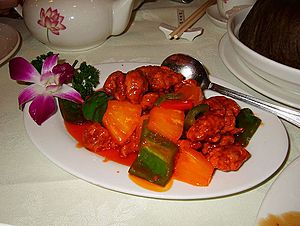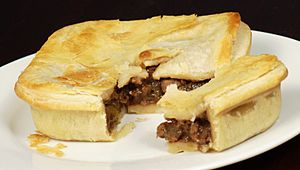Meat alternative facts for kids
A meat alternative or meat substitute is a food product made from plants or other non-animal ingredients. People eat them instead of meat. These foods often try to be like real meat in how they feel in your mouth, how they taste, how they look, or their chemical makeup.
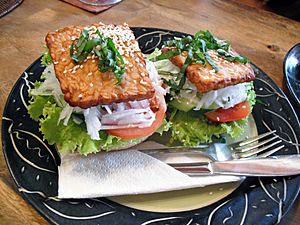
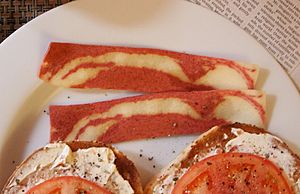
Meat alternatives often use soy (like tofu, tempeh, or textured vegetable protein). They can also be made from wheat gluten (called seitan), pea protein (like in the Beyond Burger), or mycoprotein (like Quorn).
People who are vegetarians or vegans often eat meat alternatives for dietary protein. Also, people who follow certain religious or cultural food rules use them. Lately, more people who eat meat sometimes (called flexitarians) are choosing meat alternatives. This is because they want to eat in a more earth-friendly way and reduce the impact of meat farming.
Meat substitutes have been around for a long time. Tofu was first made in China around 200 BCE. In the Middle Ages, people used chopped nuts and grapes instead of mincemeat during Lent. Since the 2010s, new companies like Impossible Foods and Beyond Meat have made plant-based versions of ground beef, burgers, and chicken nuggets very popular.
Contents
A Look Back: The History of Meat Alternatives

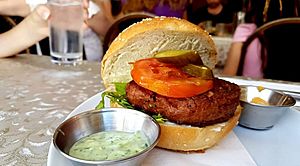
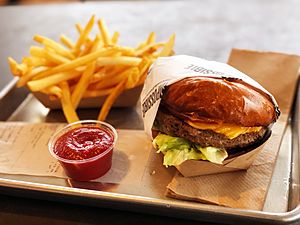
Tofu, a meat alternative made from soybeans, was invented in China during the Han dynasty (206 BC–220 CE). Pictures of tofu being made have been found in Han dynasty tombs. A writer named Tao Gu (903–970) wrote that tofu was known as "small mutton". This shows that people in China thought of tofu as a good meat imitation. Tofu was widely eaten during the Tang Dynasty (618–907). It likely spread to Japan around that time or later.
In the 3rd century CE, a writer named Athenaeus described how to make fake anchovy from a turnip!
Wheat gluten has been used in China since the 6th century. The oldest mention of wheat gluten is in a Chinese farming book from 535. It talks about noodles made from wheat gluten. By the Song Dynasty (960–1279), wheat gluten was called mian jin.
Before Buddhism arrived, people in northern China ate a lot of meat. But the Buddhist religion had rules about not eating meat. This led to the creation of many meat substitutes. Tofu and wheat gluten are still linked to Buddhist cuisine in China and other parts of East Asia.
Meat alternatives were also popular in Medieval Europe during Lent. Lent is a time when people traditionally don't eat warm-blooded animals, eggs, or dairy. During Lent, people used chopped almonds and grapes instead of mincemeat. Diced bread was even made to look like cracklings.
John Harvey Kellogg started making meat replacements around 1877. He used nuts, grains, and soy to feed patients at his vegetarian Battle Creek Sanitarium. His company sold a popular meat substitute called Protose, made from peanuts and wheat gluten.
Interest in meat substitutes grew a lot in the late 1800s and early 1900s. Before 1950, vegetarians looked for meat alternatives for ethical reasons. Also, regular meat-eaters needed them because of food shortages during World War I and World War II.
In 1898, Henrietta Latham Dwight wrote a cookbook with "mock chicken" made from breadcrumbs, eggs, lemon juice, and walnuts. In 1909, Sarah Tyson Rorer wrote a cookbook with a "mock veal roast" from lentils, breadcrumbs, and peanuts. In 1943, Kellogg made his first soy-based meat alternative, Soy Protose.
In July 2016, Impossible Foods launched the Impossible Burger. It's a beef substitute that tries to look, taste, and cook like real meat. In 2019, Burger King started selling the plant-based Impossible Whopper. It became one of Burger King's most successful new products ever! By late 2019, many other restaurants like Carl's Jr., Hardee's, A&W, Dunkin Donuts, and KFC were selling plant-based meat items.
Different Kinds of Meat Alternatives
Some vegetarian meat alternatives are based on old recipes. These include seitan (made from wheat gluten), rice, mushrooms, legumes, tempeh, yam flour, or pressed tofu. Flavorings are added to make them taste like chicken, beef, ham, or seafood.
Other alternatives use special peanut flour, yuba, and textured vegetable protein (TVP). Yuba and TVP are both soy-based. Yuba is made from the thin skin that forms on top of boiled soy milk. TVP is a dry product made from soy.
Some meat alternatives use mycoprotein, like Quorn. This is made from a type of fungus and often uses egg white to hold it together. Another type of meat alternative uses bacteria, like the company Calysta.
How Meat Alternatives Are Made
Meat alternative products are usually made using two main methods: thermoplastic extrusion or fiber spinning. Thermoplastic extrusion is a process similar to making ready-to-eat cereals. It's good for making large amounts of food and creating the right texture.
The ingredients used to make meat substitutes are always expanding. Some companies use high-protein bacteria. Others grow the root-like parts of fungi (called mycelium) to create foods that look like steaks or chicken breasts.
Most meat substitutes on the market use soy protein isolates or soybean flour and gluten as their base. Soy protein isolate is a very pure form of soy protein, with at least 90% protein. To get this protein, soybeans are first shelled. Then, solvents are used to remove the oil. The oil-free soybean meal is mixed with water and treated to dissolve the protein. This protein is then separated, washed, and dried. Removing fats and carbohydrates makes the product taste quite neutral. Soy protein is also a "complete protein," meaning it has all the important amino acids our bodies need to grow.
Fats, called lipids, are added to meat alternatives. These usually come from plants, like soybean oil, olive oil, or canola oil. While fats don't create the structure of the meat alternative, they are very important for making the food taste good and appealing to people.
Food additives are also used. These include flavorings, colors, and things that help the product expand or mix well. For example, Sodium bicarbonate (baking soda) helps create air pockets. Emulsifiers help keep the ingredients mixed together smoothly. They can also act as a lubricant during the making process.
The dry protein mix used can have between 30% and 100% protein. A mix with 100% protein creates the best fibrous texture. However, for taste, a mix with 50% to 70% protein usually gets the best feedback from people.
The Business of Meat Alternatives
Meat substitutes made up about 11% of the world's total meat and meat substitute market in 2020. This amount changes from one region to another, as shown in the graph. From 2013 to 2021, the average price of meat substitutes worldwide kept falling by about 33%. The price is expected to keep going down in the future.
People choose meat substitutes for different reasons. Many "meat-reducers" (people who want to eat less meat) are interested in them for health reasons and to manage their weight. People who are vegan, vegetarian, or pescetarian often choose them because they care about animal welfare or the environment. Also, some cultural beliefs and religions, like Hinduism, Judaism, Islam, Christianity, Jainism, and Buddhism, have rules about not eating certain animal products.
Vegan meats are sold in restaurants, grocery stores, and bakeries. They are also used in vegan school meals and at home. Sales of plant-based meats in North America grew by 37% between 2017 and 2018. In 2018–19, sales in the United States were $895 million. Experts predict the global market for meat alternatives could reach $140 billion by 2029. People are buying more meat alternatives because they want healthy options, are curious, and because veganism is becoming more popular. Some even believe that plant-based food and cultured meat will completely replace animal-based food by the year 2100.
How Meat Alternatives Help the Environment
Besides being good for ethics and health, making better meat alternatives can help reduce the environmental impact of producing meat. This is important because the world's demand for meat is expected to increase by 15% by 2031.
Studies show that meat-free products can offer big benefits compared to producing beef, and to a lesser extent pork and chicken. These benefits include less greenhouse gas production, and less use of water and land. A report from 2022 found that investing in improving and making more meat and dairy alternatives leads to much bigger reductions in greenhouse gases compared to other investments.
Some Criticisms of Meat Alternatives
Companies that make plant-based meat alternatives, like Beyond Meat and Impossible Foods, have faced some criticism. Some dietitians say these products are not always healthier than real meat because they can be highly processed and have a lot of sodium (salt).
John Mackey, who started Whole Foods Market, and Brian Niccol, CEO of Chipotle Mexican Grill, have said that some meat alternatives are "ultra-processed". Chipotle has said they won't sell these products in their restaurants for this reason. In response, Beyond Meat invited Niccol to visit their factory to see how their products are made. Chipotle later created its own "plant-based chorizo".
Some experts also want more clear information about how plant-based meats affect the environment.
In some states, laws have been made that say meat alternatives cannot call themselves "meat." For example, in Louisiana, a law called the "Truth in Labeling of Food Products Act" was challenged by Tofurkey. Tofurkey argued it violated free speech, and they won.
See also
 In Spanish: Sucedáneo de carne para niños
In Spanish: Sucedáneo de carne para niños


